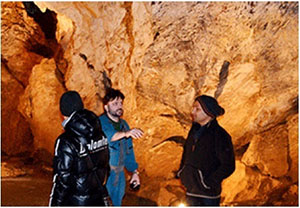
Underground Rainbow

Born in Bahrain, raised in India, frequent traveller to the Czech Republic, residing in Canada, working in the UAE and finding inspiration everywhere, Hesham Malik is a true global ‘artizen’ (artist + citizen). Nothing living is alien to him; he finds sources for his work in things ranging from grains of sand to galaxies. He is a painter with a sharp conscience too, working with differently abled children and finding time for them. He is one of the Ambassadors of the Sunrise Institute in Europe, which supports socially disadvantaged children and focuses on their talents.
His current project sees him exhibiting his works in one of the hottest caves of Europe, the Zbrašov aragonite caves in the Czech Republic.
The caves were discovered serendipitously. In 1912, workers at a local quarry uncovered a crack in the rocks with warm air coming out. Two brothers, Josef and Chrome Čeněk who were interested in the limestone formations of the area, made the opening bigger.
They climbed down a rope 138 feet into the dark. It broke and both men were trapped. Their lamps were also broken; they had to wait eight hours to be rescued.
Over the next few years, explorers and other members of local volunteers spent their free time exploring many other parts of what turned out to be a 4,337 feet cave system. Electric lighting was introduced. In 1926, the caves were made open to the public. They are now a protected area and a National Natural Landmark. Located on the bank of the Becva River at an altitude of 820 to 1,020 feet above sea level, they have a temperature of 14°C throughout. They attract more than 60,000 people a year.
A small part of the cave, at the ground level, is called the Marble Hall. The area is used for exhibitions. The exhibits have been strictly a display of marble or metal sculptures, since the high level of carbon dioxide emissions make it impossible to display paintings.
So it is with some amount of satisfaction — and a great deal of justifiable pride — the art community applauds the fact that for the first time in history, the zone management took the opportunity to integrate works of Malik into the cave spaces.
It was a challenge, but Malik took it up, though he knew that letting his work to be seen and experienced in different types of natural light and weather conditions was not going to be easy. However, he believes the touch of bright colours and silver and gold illumination (for which he is famous), will be interesting for viewers in the caves, with its dim lights and shadows.
What makes the exhibition exciting is to think of how the artist has taken the paintings created in one of the world’s most colourful and sunshiny cities – Dubai – to an underground area.
The paintings have travelled a total of 6,100 kms away from the sunshine, right into the caves. It could be a reflection of the artist’s credo to “bring art to everyone, everywhere”.
The exhibition is designed thematically, and hopes to provide “unprecedented paths for understanding the cave as a multifaceted, universal theme in contemporary art.”
Before it began, Malik focused on how his works would survive in the highly carbon dioxided caves. April – when his show began has the worst weather conditions possible in the caves. That’s when he thought he would risk his art and theories. If his paintings survived the month, the management promised to follow up with a halfyear show, open to public.
He began by testing his skills under extreme temperatures. Dubai was the perfect place which provided him with the best of natural light and high temperatures. The caves provided the opposite – humidity. This made it interesting, to say the least, as to how the artist would do and display the works.
As it turned out, he satisfied the management, wowed the viewers and has proven his skills. His show is titled ‘Caves’ and presents an assortment of artwork numbering thirty. It is a proud moment for the UAE to see one of its artists being the first to display art in the artistically untouched caves.
To add a tailpiece — though it is perhaps headlines stuff — a Russian business tycoon recently bought Malik’s painting titled ‘Elizabeth of Russia’ for $38.7 million. But it’s all in a routine day’s — or night’s — work for him (he paints during nights). He opens out here to Time Out on his new venture.
* Why did you paint in Dubai for the ‘Caves’ show? Why did you call it ‘Caves’?
As an artist, I have always tried to bring out the best on a canvas. What I realised is when I paint away from the city hosting the show, I had much more to add onto the canvas, when it comes to creativity.
Having said that, I have been in Dubai since 1989 and it is like home for me. As an artist, I like the energy of the city, the people, the climate and the lights around it.
The nights are silent. Since I paint only at night, it really matters how they are. Above all, I think I do justice to the theme and paintings when I am allowed to work in isolation.
It is called ‘Caves’ because I have always read and studied the subject. I use to find it interesting and it challenges me as an artist. The whole point is that before cities existed and before huge markets came into being, all we humans had were caves.
Within those caves we found enlightenment; within them we spoke to angels and within them we found ways to live a better life.
There are many who returned back to these caves to study or to meditate or feel their natural beauty. So basically the pieces display the myths surrounding different caves and groups of people. Yes, I could give it a fancy name; but I wanted to keep it simple!
* What are the techniques you used for the paintings to survive?
I have always been using layers, around five to seven. So basically I cover the whole canvas with five to seven layers of colours. In the end, I peel off the last layer, creating the final image.
In this particular case, I used up to 14 layers. After peeling off the last layer and the final painting was ready, I had to varnish the paintings. The varnish had to be made according to the conditions of the caves. So the percentage of acid had to be reduced and the chemicals had to be balanced to help the paintings survive within the caves. Obviously, this was done after neverending experiments of trial and error.
After completion, the paintings were placed in an acrylic base box. What happens is that the caves would cause droplets of water to fall on the box. As an artist, I believe this makes the works more artistic.
* What are the challenges you faced while creating and displaying the artworks?
The challenges were obviously trying to work with different layers. How to get the correct combination? As mentioned above, after the painting was completed, I had to figure out how to create the perfect varnish. Above each painting were multiple layers of varnish!
The question of how to place the paintings around the caves then came up. Since no easels or boards were allowed, they had to be stored inside acrylic boxes and positioned on stones.





